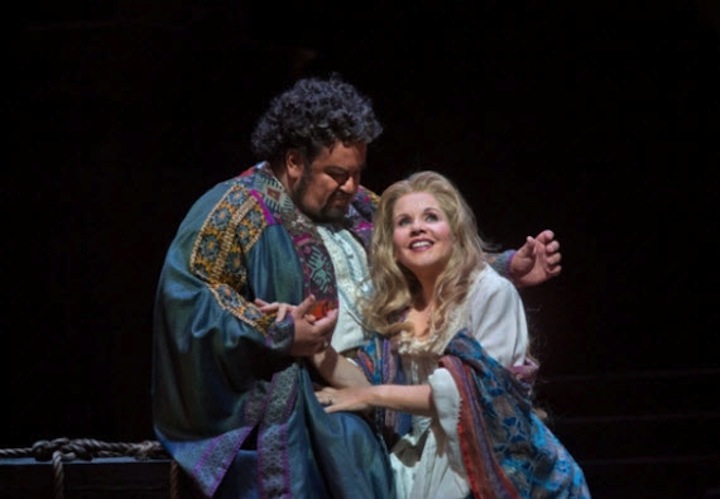
Toronto filmmaker Babara Willis Sweete, one of the key directors of Metropolitan Opera high-definition broadcasts since their début six years ago, has a lot to keep track of during a live performance broadcast.
- Classical Music 101: What Does A Conductor Do? - June 17, 2019
- Classical Music 101 | What Does Period Instrument Mean? - May 6, 2019
- CLASSICAL MUSIC 101 | What Does It Mean To Be In Tune? - April 23, 2019
I’ve tried twice to get a date in the master control truck, with no response from Sweete. Thierry Hillériteau of France’s Le Figaro newspaper was luckier, publishing a great account of the goings-on behind the scenes yesterday. I’m taking the liberty of sharing the story by translating the article below. You can find the original here.
Renée Fleming enters box 510 looking Patrician. Judging from her good mood, she’s proud of her performance. She can be: She has just been assassinated in front of an audience of 250,000 in Elijah Moshinsky’s production of [Verdi’s] Otello. This classic was broadcast live to 54 countries.
“We can’t measure how these broadcasts are changing the world of opera,” says Fleming, who is a keen advocate. When she isn’t singing in them, she often plays the role of presenter.
These high-definition broadcasts have already shaken up life at the Metropolitan Opera in New York, which pioneered the form when it launched its HD broadcasts to cinemas in 2006.
With its 3,800-seat hall and 1,600 employees, its costume and set studios, the world’s biggest opera company is a hive of activity. “But on broadcast days, it’s best to watch your step,” warns live broadcast boss Mia Bongiovanni.
By 10 a.m., the set is already a battlefield. Scenery gets minute touch-ups (because the HD cameras pick up every detail); prompters, actors and Steadycam operators rehearse the intermission interviews. Lighting technicians are making final adjustments during the run-through of a swordfight that is as tightly scripted as the opera itself, while the broadcast producers test each of the remotely-controlled cameras, including one on tracks placed at stage level.
“Nothing can be left to chance,” says director Barbara Willis Sweete.
Anything can happen during these broadcasts; it’s the rule of live video. For Otello, Sweete has had to orchestrate no less than 1,100 different camera angles — 200 of which are in motion, made possible by the camera on rails. These shots help give momentum to the singers’ long-held notes.
“Some last for 60 seconds. Believe me, a lot of things can happen in 60 seconds, so our role is to anticipate everything,” says Sweete. She and her 60-person team (camera operators, script coordinators and sound engineers) follow a production from beginning to end by including in her team one of the assistant directors of each opera. This helps her anticipate any difficulties and instances where she needs to go her own way in presenting what’s happening on stage.
“There is no conflict of interest, but our priorities are different,” Bongiovanni explains. “The director has to think dramaturgically and see the big picture. We are focused on details like facial expressions and body language that can have a completely different effect when seen through a camera lens.”
A week before a live broadcast, the team goes through a full-on test with all 10 HD cameras, then spends four days going marking up the score, scene by scene.
We were able to sneak into the production truck during the broadcast of Otello. For the uninitiated, the unfolding drama has the feel of something minimalist by Philip Glass. Twelve people, including Sweete and Met general manager Peter Gelb are at full attention, following the score by bar number and its attendant instructions by camera number and length of shot.
Sweete raps on the table to keep rhythm — tapping a second time if there’s a change of plan. The technicians poke away at a console that looks like an exile from a sci-fi movie, eyes glued to 30 or so screens that show the view from each camera.
An occasional exclamation of Bravo interrupts the rhythm, rewarding a singer or, in one instance, a successful cut to a different camera so that cinema audiences were spared the sight of large beads of sweat running down Otello’s face.
During the intermission, an assistant director gets agitated. The camera has just zoomed in on a lighting technician up in the flies. “Look busy, look busy,” yells the director to a deaf monitor.
“We always prefer to see something unexpected happen rather than nothing at all,” Sweete explains afterward.
She has had her fair share of cold sweats during the course of the performance.
At the end of the opera, when Desdemona dies, Fleming had fallen further than expected. The tension in the truck reached its peak. “We had to change the shot at the last moment with a Steadycam,” the director says. “The cameraman in charge of it is a virtuoso.”
But for viewers in cinemas, the quick save passed unnoticed.
Thierry Hillériteau
- The next Met HD Live show is a visually stunning Robert Lepage production of The Tempest by Thomas Adès, airing next Saturday (Nov. 10) at participating Cineplex theatres. There is a variety of videos and other background information on the 8-year-old opera and this production here.
- Classical Music 101: What Does A Conductor Do? - June 17, 2019
- Classical Music 101 | What Does Period Instrument Mean? - May 6, 2019
- CLASSICAL MUSIC 101 | What Does It Mean To Be In Tune? - April 23, 2019



